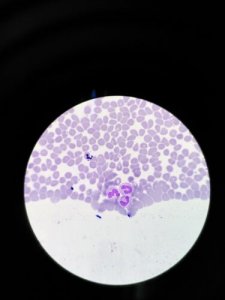Agranulocytosis: Symptoms and Treatments

Agranulocytosis is a disease of the blood that is when the number of granulocytes becomes too low. Agranulocytosis is also called neutropenia or granulocytopenia. According to the most widespread definition, it occurs when the number of neutrophils is less than 1,000 – 1,500 cells per cubic millimeter of blood. Overall, there are three types of granulocytes: Neutrophils, Eosinophils, and Basophils.
This is a rare but potentially serious disease. In this article, you will learn what this disease is and what its symptoms are.
Agranulocytosis is a blood disease. It occurs where there is a decrease of granulocytes in the blood. Granulocytes are cells present in our blood and are primarily responsible for fighting infections.
Why does agranulocytosis occur?
As you have seen, agranulocytosis is a disease that occurs when the number of neutrophils in the blood decreases. This can occur due to two different reasons:
- Ineffective granulopoiesis: There is a failure during the process of creating neutrophils, which takes place in the medulla. Therefore, any spinal disorder can cause this. For example, it can occur due to aplastic anemia or leukemia.
- Early destruction or use of neutrophils: If this occurs faster than the marrow can generate new neutrophils, agranulocytosis can develop. Neutrophils are the cells responsible for fighting bacterial infections. As a result, they will be working overtime in these situations.
- On the other hand, premature destruction can occur due to certain medications, such as metamizole. Also, this can happen due to radiation or autoimmune processes.
Thus, the possible causes of agranulocytosis can be:
- Genetic: When the production of the cells is altered by a problem in the genes.
- Congenital: In some cases, you can be born with this disease.
- Acquired: Agranulocytosis may be brought about by drugs or as a consequence of malignancies.
You might like: Celery Seeds: A Natural Tea for High Blood Pressure
You might like: How to Increase Red Blood Cells
How agranulocytosis is classified
The severity of agranulocytosis is classified according to the number of neutrophils in the blood. Thus, the different classifications are:
- Mild: The number of neutrophils is less than 1,000 – 1,500 cells / cubic millimeter of blood.
- Moderate: The number of neutrophils is less than 500 – 1,000 cells / cubic millimeter of blood.
- Severe: The neutrophil count is less than 500 cells / cubic millimeter of blood.
Symptoms
This disease often has no specific symptoms. In fact, it can even go unnoticed. However, some of the most common signs are:
- Fever greater than 38 ° C, usually accompanied by chills and sweating.
- Cough and shortness of breath.
- Weakness and fatigue.
- Mouth sores and vascular ulcers.
- Discomfort when urinating.
- Vomiting and diarrhea.
Additionally, for women, there may be a change in vaginal secretions. The important thing is to know that the patient suffers from infections more frequently. Also, they tend to be very unusual or uncommon infections.
Diagnosis
Doctors may suspect this disease when the patient frequently suffers from infections. First, the doctor will order a blood test, which will show a low number of granulocytes if the patient has the disease. Also, the bone marrow can be examined by biopsy or aspiration.
Other tests that serve to reach the diagnosis are:
- Analysis of urine or other fluids: This way, infectious agents can be found if the person has a fever.
- Genetic testing.
- Antibody tests: They are useful to rule out an autoimmune cause.
Treatment of agranulocytosis
The treatment depends on the cause and the severity of the case. Thus, if the cause is pharmacological, the patient must stop taking the medicine causing it immediately. If you can’t, ideally you should try to replace the drug with another one. Also, doctors should order control blood tests.
In the case of infection, the patient should take antibiotics. The most widespread strategy is to take antibiotics against the most common microorganisms. When agranulocytosis is due to an autoimmune disorder, corticosteroids can lead to good results.
Also, there are currently more specific treatments, such as:
- Leukocyte transfusion.
- Granulocyte colony-stimulating factor (G-CSF): This is a method that stimulates the bone marrow to produce more granulocytes. This treatment is especially effective in people whose agranulocytosis is due to chemotherapy.
- Bone marrow transplant: This is reserved for cases where other treatments have not worked. A healthy bone marrow can produce healthy granulocytes. However, it’s difficult to find compatible donors.
Conclusion
Agranulocytosis is a complex blood disease. It’s necessary to see a doctor if you suffer from infections frequently and suspect you may have it. You should also see the doctor if you feel weak, have a fever or any other symptoms mentioned. The doctor will perform the appropriate exams and prescribe the necessary treatment.
All cited sources were thoroughly reviewed by our team to ensure their quality, reliability, currency, and validity. The bibliography of this article was considered reliable and of academic or scientific accuracy.
- Agranulocitosis. Síntomas, causas y tratamiento. (n.d.). Retrieved May 21, 2019, from http://leucocitos.org/granulocitos/agranulocitosis/
- Agranulocitosis: Definición, Causas, Síntomas, Tratamiento y Más. (n.d.). Retrieved May 21, 2019, from https://superatuenfermedad.com/c-sangre/agranulocitosis/
- Agranulocitosis – Cancer Care of Western New York. (n.d.). Retrieved May 21, 2019, from https://www.cancercarewny.com/content.aspx?chunkiid=195965
- Agranulocitosis: Qué es, cualés son los síntomas y cómo tratarla. (n.d.). Retrieved May 21, 2019, from https://www.lavanguardia.com/vida/salud/enfermedades-sangre/20190414/461641314222/neutrofilos-eosinofilos-basofilos-agranulocitosis-neutropenia-granulocitopenia-sangre-infecciones.html
- Díaz Valiente, O., Sandrino Sánchez, M., & Pérez Martin, M. M. (2017). Revista de ciencias médicas de Pinar del Río. Revista de Ciencias Médicas de Pinar del Río (Vol. 21). 1999, Editorial Ciencias Médicas. Retrieved from http://scielo.sld.cu/scielo.php?script=sci_arttext&pid=S1561-31942017000500019
This text is provided for informational purposes only and does not replace consultation with a professional. If in doubt, consult your specialist.










